#testudines
Text
Sleeping sea turtle.
🔊 Sound on for bubbles 🫧
#herpetology#sea turtles#turtles#reptiles#reptiblr#ocean#ocean creatures#Testudines#animal videos#video#sea turtle#cheloniology#chelonology#testudinology#sea turtle sleeping underwater#there are many benefits to being a marine biologist#marine biologist#marine biology#top post
18K notes
·
View notes
Text
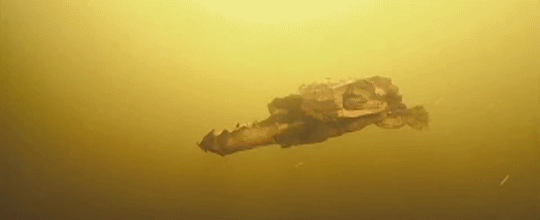
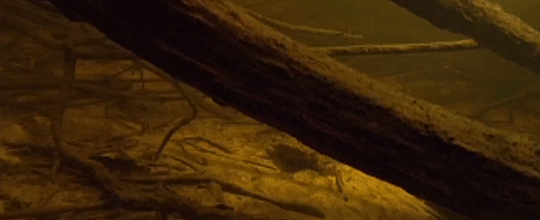


The unique and irregular appearance of the mata mata helps it to camouflage among dead leaves and branches in the water, where it lies in wait for passing fish.
©
301 notes
·
View notes
Text
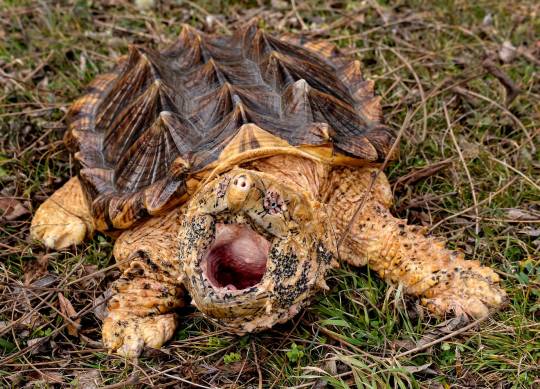


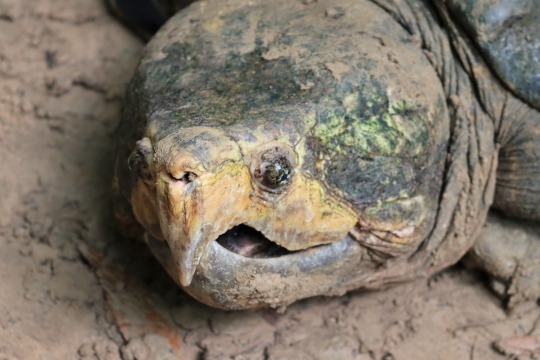
The Stupendous Alligator Snapping Turtle
Alligator snapping turtles (Macrochelys temminkii) are one of three recognised species of snapping turtle, all of which are found in North America. This particular species is found in the southeastern United States and the Mississippi Basin in particular. Macrochelys temminkii prefers deep freshwater, and is especially common in deep rivers, wetlands, and lakes.
The alligator snapping turtle is the largest freshwater turtle in North America, and is one of the heaviest in the world. Most individuals weigh between 70-80 kg (154-176 lbs), and are about 79-101 cm (31-39 in) long. However, the largest verified indiviual weighed over 113 kg (249 lb), and many others have been recorded in excess of 100 kg. The species is easily identifiable by its large, boxy head and thick shell with three rows of raised spikes. Typical alligator snapping urtles are solid black, brown, or olive green, though the shells of many older individuals can be covered in green algae.
M. temminkii is famous for its strong bite, which is most often utilised when feeding. The turtle's tongue resembles a worm, and at night individuals lie on the bottom of the river or lake bed with their mouths open. Fish are enticed by the bait-tongue, and when they get close enough the alligator snapping turtle's mouth clamps down around them. In addition to fish, this species may also feed on amphibians, invertebrates, small mammals, water birds, other turtles, and even juvenile alligators where their territories overlap. The alligator snapping turtle's relies on ambush techniques, and so hunters can remain submerged for up to 40 minutes. In some cases, individuals can also 'taste' the water to detect neaby mud and musk turtles. Because of this species' thick shell and ferocious bite, adults have few predators, but eggs and hatchlings may fall prey to raccoons, predatory fish, and large birds.
This species spends most of its time in the water, only emerging to nest or find a new home if their current habitat becomes unsuitable. Mating occurs between Februrary and May, starting later in the northern regions of the species' range. Males and females seek each other out, but generally don't travel great distances. About two months after mating, females dig a nest near a body of water and deposit between 10-50 eggs. Incubation takes up to 140 days, and the average temperature of the nest determines the sex of the hatchings; the hotter it is, the more males are produced. In the fall, hatchings emerge and are left to fend for themselves. Sexual maturity is reached at between 11 and 13 years of age, and individuals can live as old as 45 years in the wild.
Conservation status: The alligator snapping turtle is listed as Vulnerable by the IUCN. The species is threatened by overharvesting for meat and for the pet trade, and by habitat destruction.
If you like what I do, consider leaving a tip or buying me a ko-fi!
Photos
Ed Godfrey
Cindy Hayes
Eva Kwiatek
Nathan Patee
#alligator snapping turtle#Testudines#Chelydridae#snapping turtles#freshwater turtles#reptiles#freshwater fauna#freshwater reptiles#lakes#lake reptiles#wetlands#wetland reptiles#rivers#river reptiles#north america#southern north america#animal facts#biology#zoology
455 notes
·
View notes
Text
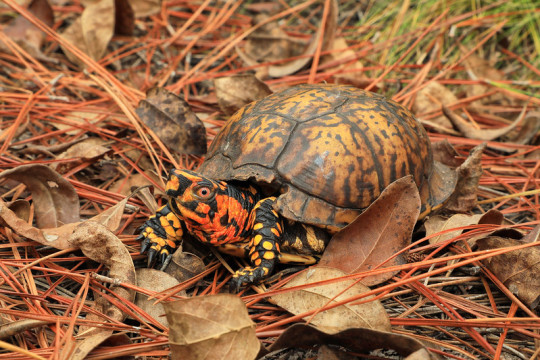
An Eastern box turtle (Terrapene carolina carolina) in Emmanual County, Georgia, USA
by Alan Cressler
#eastern box turtle#common box turtle#turtles#tortoises and turtles#reptiles#terrapene carolina carolina#terrapene carolina#terrapene#Emydidae#testudines#reptilia#chordata#wildlife: georgia#wildlife: usa#wildlife: north america
107 notes
·
View notes
Text
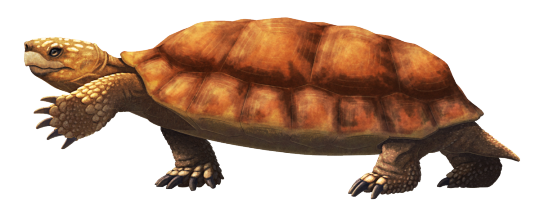
Jiangxichelys neimongolensis was a terrestrial turtle that was part of an extinct group known as nanhsiungchelyids, whose closest living relatives today are the aquatic softshell turtles.
(This species was previously known as "Zangerlia” neimongolensis, but has since been moved into the genus Jiangxichelys instead.)
It lived towards the end of the Cretaceous, about 75-71 million years ago, in what is now the Gobi Desert – which at the time was more of a semi-arid climate with both rivers and sand dunes.
Its 60cm long (~2') carapace had a long wide shape that made it appear rather flattened from the front, but not to quite as much an extreme as its larger American cousin Basilemys.
Several fairly well-preserved specimens have been found that appear to have been buried alive, probably either engulfed by sudden sandstorms or trapped in collapsing burrows. This has preserved some anatomical details previously unknown in nanhsiungchelyids, such as the pattern of scales on top of the head and the presence of large bony osteoderms on the underside of the front toes, which may have aided with traction on loose sandy ground.
———
NixIllustration.com | Tumblr | Patreon
References:
Brinkman, Donald, and Jiang-Hua Peng. "A new species of Zangerlia (Testudines: Nanhsiungchelyidae) from the Upper Cretaceous redbeds at Bayan Mandahu, Inner Mongolia, and the relationships of the genus." Canadian Journal of Earth Sciences 33.4 (1996): 526-540. https://doi.org/10.1139/e96-041
Brinkman, Donald B., et al. "New exceptionally well-preserved specimens of “Zangerlia” neimongolensis from Bayan Mandahu, Inner Mongolia, and their taxonomic significance." Comptes Rendus Palevol 14.6-7 (2015): 577-587. https://doi.org/10.1016/j.crpv.2014.12.005
Jerzykiewicz, T., et al. "Djadokhta Formation correlative strata in Chinese Inner Mongolia: an overview of the stratigraphy, sedimentary geology, and paleontology and comparisons with the type locality in the pre-Altai Gobi." Canadian Journal of Earth Sciences 30.10 (1993): 2180-2195. https://doi.org/10.1139/e93-190
Tong, Haiyan, and Lu Li. "A revision of the holotype of Nanhsiungchelys wuchingensis, Ye, 1966 (Testudines: Cryptodira: Trionychoidae: Nanhsiungchelyidae)." Cretaceous Research 95 (2019): 151-163. https://doi.org/10.1016/j.cretres.2018.11.003
Tong, Haiyan, et al. "New material of Jiangxichelys ganzhouensis Tong & Mo, 2010 (Testudines: Cryptodira: Nanhsiungchelyidae) and its phylogenetic and palaeogeographical implications." Geological Magazine 154.3 (2017): 456-464. https://doi.org/10.1017/S0016756816000108
Wikipedia contributors. “Nanhsiungchelyidae.” Wikipedia, 19 Nov. 2023, https://en.wikipedia.org/wiki/Nanhsiungchelyidae
#science illustration#paleontology#paleoart#palaeoblr#jiangxichelys#zangerlia#nanhsiungchelyidae#cryptodira#turtle#testudines#pantestudines#reptile#art#ancient mutant fossil turtles#turtle power
147 notes
·
View notes
Text


I was out for a walk in my parents' neighborhood the other day when I happened across this lovely three-toed box turtle (Terrapene triunguis). Box turtles are one of the things I've missed since moving to the PNW almost two decades ago, so it was lovely to get to see one of my favorite reptiles in the flesh after so long. This one looks like they've been in some scrapes over the years given the condition of the shell, but they looked to be in good health otherwise. Good luck, little buddy!
#turtle#box turtle#turtles#terrapins#reptiles#herps#herpetology#Testudines#vertebrates#animals#wildlife#native species
164 notes
·
View notes
Photo

One Happy Family
244 notes
·
View notes
Text
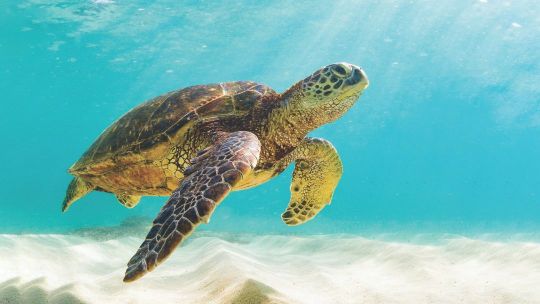

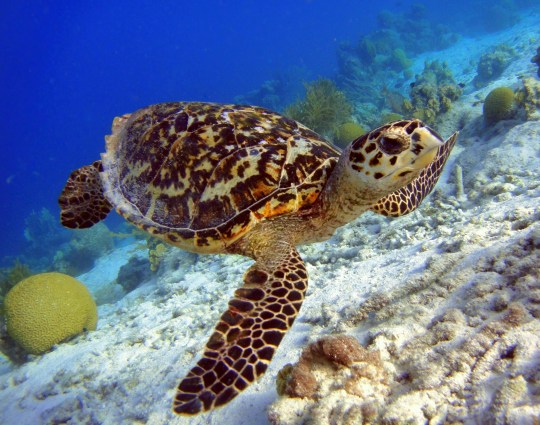

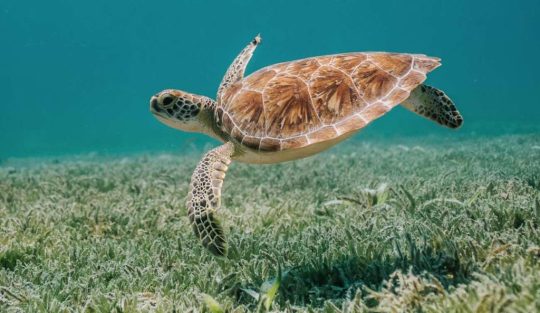


#turtle#sea turtle#marine turtle#testudines#poll#personally i am fond of the humble leatherback...but i love flatbacks too
54 notes
·
View notes
Text
A Trachemys dorbigni (tigre d'água) from the lake in my workplace


#brazil#latin america#biology#science#zoology#biologia#Trachemys dorbigni#turtles#turtle#tartaruga#tigre d'água#testudinidae#testudines
19 notes
·
View notes
Text
Bashuchelys
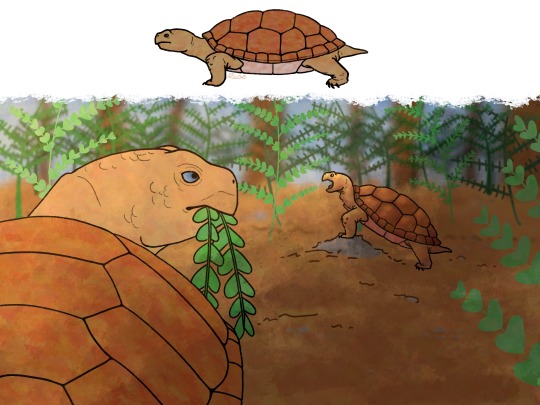
Bashuchelys was a genus of bashuchelyid turtle from the Middle Jurassic. Its type species is B. zigongensis. The other included species is B. youngi. Its known specimens were found in the Sichuan Basin, China. Bashuchelys' known material is made up of many fossils originally assigned to Chengychelys.
"Bashu" means "Bashan," which refers to both the Ba mountain of the Chongqing area and the Shushui river system (also an alternate Chinese name for the Sichuan-Chongqing area). "chelys" is greek for turtle. B. zigongensis, originally assigned to Chengychelys, is named after the nearby town of Zigong, China. B. youngi honors the original discoverer of Chengchelys, C. C. Young.
Its autapomorphies include one pair of mesoplastra that meet at the midline, a hypoplastron-mesoplastron suture that is very close to the pectoroabdominal sulcus, regular and elongate neural series, the fourth vertebral scute is twice as wide as it is long and notably
wider than the third vertebral, a sulcus between the third and fourth vertebrals on the sixth neural, the plastron sutured to the carapace, a fan-shaped bridge with long axillary and inguinal buttresses, a short area of contact between the epiplastra at the midline, the humeropectoral sulcus lying far anterior to the axillary notch, a notably longer pectoral scute than the abdominal, an omega-shaped femoroanal sulcus that extends onto the hypoplastron, a leaf-shaped entoplastron with serrated posterolateral
margins, one pair of intergulars extending deeply onto the endoplastron, and four inframarginals.
Bashuchelys is known from several shell fossils of various completeness. Its family, Bashuchelyidae, is a primitive member of Cryptodira.
Citations: Bashuchelys formal diagnosis; "Chengchelys" baenoides description; "Chengchelys" zigongensis description
Wikipedia article: here
#reptile#reptilia#turtle#paleoart#paleontology#artwork#original art#human artist#bashuchelys#bashuchelyidae#cryptodira#testudines#obscure fossil animals#obscure fossil reptiles#obscure fossil tetrapods
12 notes
·
View notes
Text
Anyone who works with wildlife will tell you it’s a good thing for wild patients to show hostility towards humans even after a long stay in the hospital, and honestly I think snapping turtles might be the best at this. We surgically repaired this little dude’s broken mandible and provided care in hospital for a few months but bless his heart he never stopped hating my fucking guts. Even with a broken jaw he’d snap at me so viciously whenever I had to give him meds and I love him like a son


This feisty creature’s implant was removed once he’d healed and he was successfully released back into the wild near where he was found. Good luck out there bud, I sincerely hope every wildlife patient I ever see going forward has your disdain for humans!
(These photos were taken while the patient’s enclosure was being cleaned, and he was never handled without medical or husbandry cause)
#animals#wildlife#snapping turtle#chelydra#turtles#chelonian#vetblr#wildlife medicine#zoology#nature#biology#veterinary medicine#testudines#funny#reptiles#reptiblr#herpetology#herpblr#my sweet boy#speedy- not named by me
14K notes
·
View notes
Photo
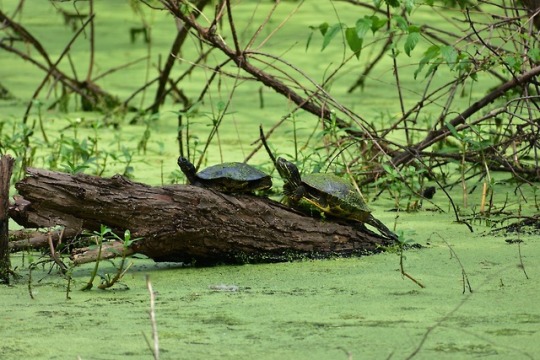
I may very well have already posted this.
#red-eared slider#red-eared terrapin#conservation status: least concern#Animalia#Chordata#Reptilia#Testudines#Cryptodira#Emydidae#Trachemys#Trachemys scripta#Trachemys scripta elegans#turtles#pond turtles#marsh turtles#subspecies#Nikon D3400#nikonphotography#my reptiles#nature photography#photographers on tumblr#Black Bayou Lake National Wildlife Refuge#feral animals#invasive reptile species#turtles of Europe#reptiles of North America#reptiles of the United States#wildlife
12 notes
·
View notes
Text




🐢🛡️spotted turtle combat🛡️🐢
74 notes
·
View notes
Text
Uncharismatic Fact of the Day
Do you hate getting water up your nose? The Aldabra giant tortoise doesn't! In fact, this species drinks through their nose; their flat snouts are specially designed to allow them to draw water from shallow pools, which is critical in an environment where water is scarce.

(Image: An Aldabra giant tortoise (Aldabrachelys gigantea) wearing a fashionable hat (Telfair's skink) by Nik Cole)
If you like what I do, consider leaving a tip or buying me a kofi!
238 notes
·
View notes
Text

A Malaysian snail eating turtle (Malayemys macrocephala) in Bangkok, Thailand
by Isabella Chowra
#malaysian snail-eating turtle#turtles#reptiles#malayemys macrocephala#malayemys#Geoemydidae#testudines#reptilia#chordata#wildlife: thailand#wildlife: asia
95 notes
·
View notes
Text
hello again rise fans!!
are you looking for a species of turtle to base your oc on but don't know which one to pick? then boy, do i have the post for you!
testudines are a surprisingly diverse order, so i'll split this up into multiple sections - but for now, here is a small collection of colorful and uniquely patterned species! pictures, facts, and scientific names can be found below the cut <3
PART ONE: Colors and Patterns
The Painted Terrapin (Batagur borneoensis)
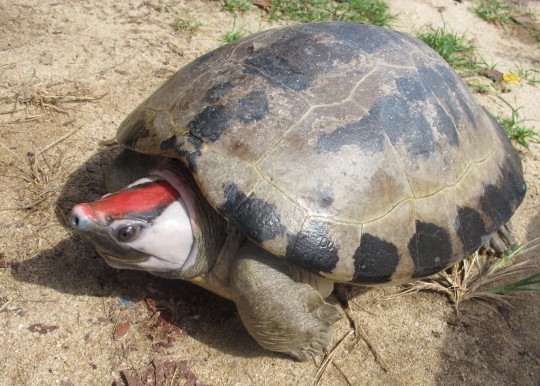
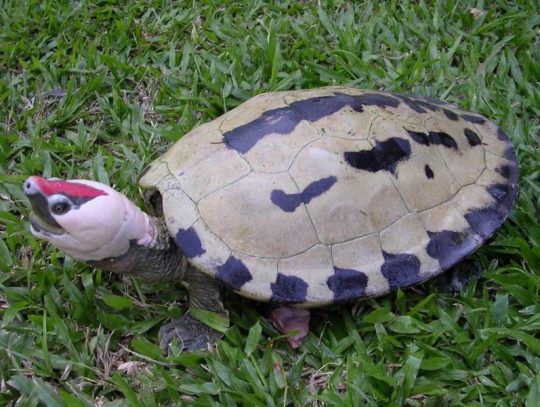


the painted terrapin (also called the saw-jawed turtle) is a rainforest dwelling species found in Indonesia, Thailand, and Malaysia. they sport incredibly unique markings on their heads, as well as very interesting shell markings. sadly, they're also critically endangered. luckily conservation efforts are place to keep these wonderful animals around <3
The Red-Crowned Roofed Turtle (Batagur kachuga)



aptly nicknamed the "Bengal roof turtle," these lil guys are only found in South Asia, and are also critically endangered. Like the painted terrapin, conservation efforts are also in place to keep them around :)
interesting fact about their coloration: after the rainy season, the males develop the extravagant coloration pictured above as part of courtship rituals! :D they're also one of many species that sunbathes on rocks to thermoregulate :)
The Northern Red-Bellied Cooter (Pseudemys rubriventris)

don't let the lighter underbelly pictured above fool you! this lil buddy is a younger turtle. their colors actually darken as the animal ages, until you get something like this!

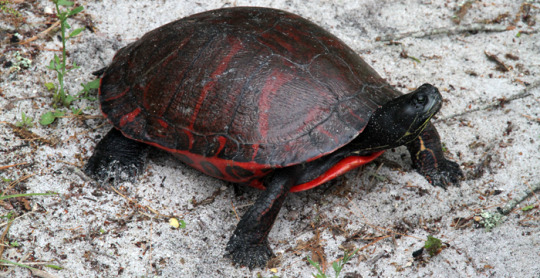

their shell patterns can also vary a bit and look something like this! very cool leopard print-style markings <33
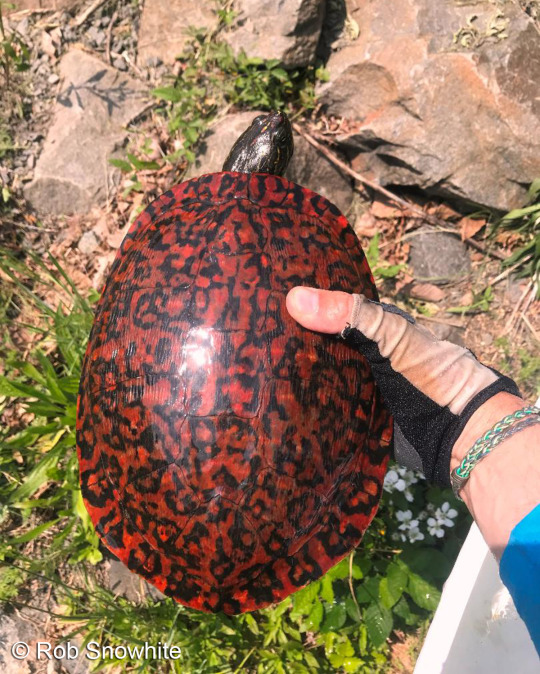
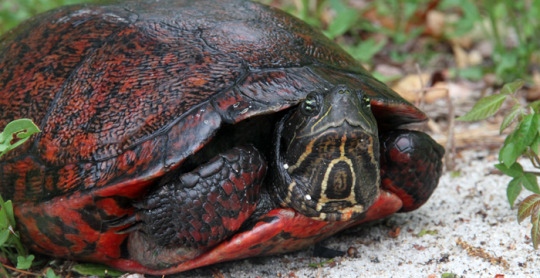
The Malaysian Box Turtle (Cuora amboinensis)




these babies are a species of Asian box turtle, and can be found in (you guessed it) Asia! these guys in particular are sometimes kept as pets, and understandably so! they're pretty neat little fellas <3
the stripes along their heads look super cool! plus their interestingly-patterned plastron can make for some awesome character designs :D
The Diamondback Terrapin (Malaclemys terrapin)

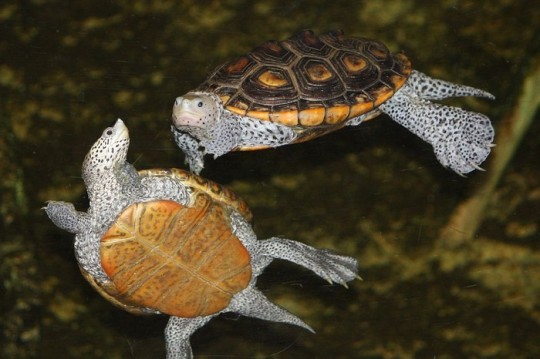
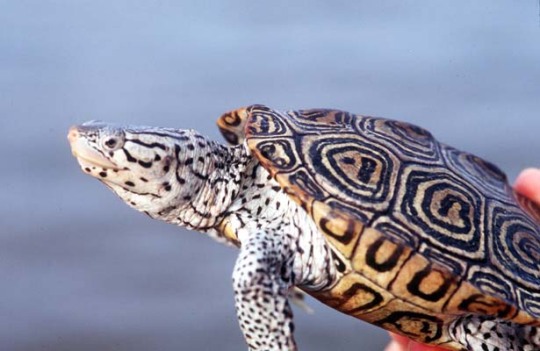

containing several subspecies, these little dudes live in water near the shores of Bermuda and the United States. they're strong swimmers, with very well developed hind flippers. i chose these guys because of the spot patterns on their skin which could be made into freckles!
some subspecies, like the Texas diamondback terrapin (pictured below), have three spikes along the backs of their shells, which could make for a sick design aspect >:) these particular ones also have a sort of blunt snout, which is cool!



thank you for reading!
information sourced from Wikipedia; all photographs belong to their respective owners
#rise of the teenage mutant ninja turtles#rise of the tmnt#rottmnt#rottmnt oc#gonna tag this as zoology cuz it also applies#zoology#turtles#cool turtles#testudines#herpetology#long post#tomothy rambles#endangered species
36 notes
·
View notes